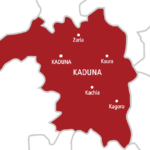Engineer MOHAMMED LAWAL MAGAJI is the Managing Director of Kaduna State Roads Agency (KADRA), which supervises and manages all roads in the state.
In this interview, MAGAJI explained why the government dismantled Kawo bridge, the gateway to the North West and North East geopolitical zones, for a more befitting one. Also, he highlighted some salient features of the new bridge.
The contract for the re-construction of Kawo bridge was awarded in November 2019 and the contractor mobilized to the construction site almost immediately. About eight months after, how far has the project been progressing?
The contract was awarded in November 2019, documentation and mobilization of the contractor followed. Christmas and New Year break then came up afterwards. Work started in January this year, with the construction of alternative routes.
Kaduna State Government is very particular about diversions and alternative routes to ease the movement of people coming in and out of Kaduna city during the construction works. The contractor started with the construction of these alternative routes which have been completed and are opened to traffic.
Can you give a detailed description of these alternative routes and how they are serving the purpose for which they are constructed?
The alternative routes were designed to ensure free flow of traffic that will not hinder the construction of the new bridge. They have been completed and are catering for the influx of traffic from Zaria, Mando area of Kaduna town and the Western bye-pass, especially for those heading to Abuja. For those coming from Zaria, we have four lanes with shoulder.
The four lanes are separated with a barrier with two lanes and a shoulder to serve the traffic going to Mando and Western bye pass to Abuja. The other two lanes are for the traffic that are coming into Kaduna. Trucks and tankers ply the lane leading to Mando. We created a shoulder and enough space; so that in case of breakdown of vehicles, the traffic can still flow to Mando road.
The traffic coming from Mando or Western bye pass will have two lanes with shoulder that leads to Ali Akilu road. The traffic will continue to flow until it gets to a U-turn at the Saint Patrick Catholic Church. We have observed that there is a lot of gridlock caused by trailers at that U-turn. We solved this problem by separating the lanes, by making provision for trailers and tankers from other vehicles.

The available route for those who are heading east but are not going outside Kaduna city, is to ply Lafiya and Darma roads, so as to decongest the bridge location. A lane separating tankers and small vehicles also exists on both roads to ease vehicular movement before Sabon Birni junction. The lane provided for tankers is spacious enough to have two tankers side by side on the single carriageway. However, the residential status of the area used to be a stumbling block to the free flow of traffic as residents parked their vehicles on the roadside. But in order to ease this distress, we made provision for a parking space to cater for vehicles of the residents. But we still have violators who still park on the road. The Sabon Birni to Rafin Guza and Kawo new extension road linking to the bridge has been blocked. However, a U-turn is still accessible for vehicles to turn and link up to Lafiya road.
Are there adequate signage, traffic wardens to manage the flow of traffic?
We have provided various signage but we discover that it is not enough because of the attitude of some road users. We have signage direction for people going in and out of Kaduna city. We have diversion signs placed at strategic areas before getting to the main signage. To ensure enforcement and compliance, we met with major stakeholders like Kaduna State Traffic Law Enforcement Authority (KASTELEA), Federal Roads Safety Commission (FRSC), the Nigerian Police and other traffic management bodies, where we discussed how to effectively manage traffic flow on our roads.
Were there identifiable defects on the old structure that necessitated the dismantling of the entire bridge, instead of just improving on it?
The old bridge was structurally sound but it was a narrow bridge with a parabolic shape. With the expansion of Ali Akilu road and Kaduna-Zaria express way, the bridge became grossly inadequate to serve its designed purpose. With this in view, the Kaduna State Government embarked on the reconstruction of a new bridge to accommodate more vehicular movements and ease the problems experienced at the location.
Will the raining season not affect the ongoing construction of the bridge? Is the envisaged the 20 months completion period still feasible?
The rains will not adversely affect the ongoing construction because the bridge is a concrete structure which requires curing for its strength. Curing is done with water thus the rains will help in strengthening the cast concrete. We will use the raining season to our advantage by planning the sequence of construction and embark on the piling process. We will not have much problem with the rains, it won’t hinder the work progress.

Can you give a more detailed description of the features of the new bridge?
The new bridge will have a dual carriageway with shoulder and pedestrian walkway on the sides. The length of the bridge is 832 meters long and the width is 22 meters. The bridge was designed with 3 ground rotaries (roundabouts) under the bridge. One of the ground rotaries will cater for the traffic from Sabon Birnin axis and Kawo New Extension. The second roundabout is located at the centre, under the bridge, to cater for the traffic from Mando axis, the third roundabout will cater for the traffic from 1 Mechanised Division (Dalet Barrack) and commuters from Zaria making a U-turn or heading to Unguwan Kaji. We want the bridge to be of standard and one of the best in the north.


 Join Daily Trust WhatsApp Community For Quick Access To News and Happenings Around You.
Join Daily Trust WhatsApp Community For Quick Access To News and Happenings Around You.

